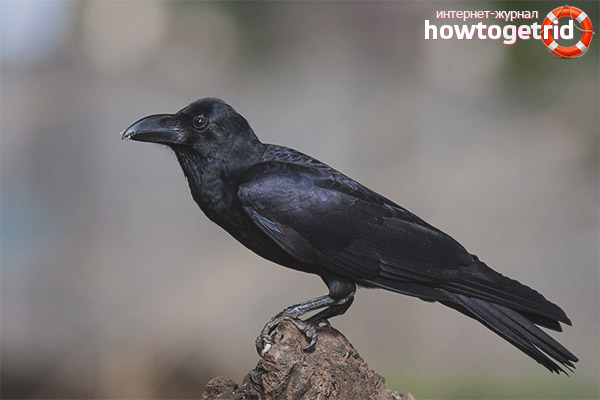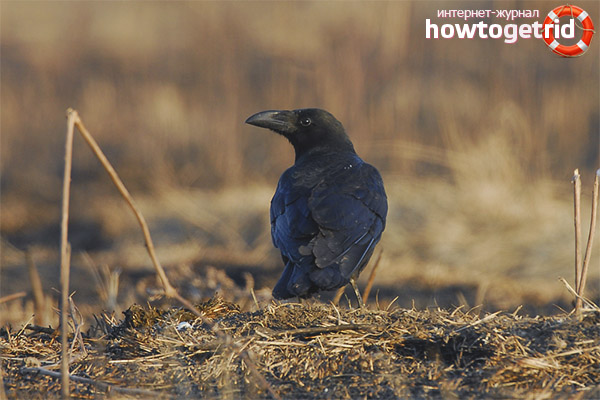The content of the article
The large-billed crow is distinguished by the size of its beak, which is disproportionately large. The plumage located on the head of this bird, its wings and its tail are colored black with a characteristic green and purple tint. The bird has a wedge-shaped tail, there is no beard on its throat that distinguishes the closest relatives of this crow.
The sizes of the representative of this species do not have clear limits, they can range from 46 to 59 centimeters, the approximate weight of an adult reaches 1.3 kilograms. The large-billed crows that live in the northern regions are usually larger than the representatives of the southern region. The difference is noticeable both in the size of the beak and in the structure of the plumage located under the beak of the bird.
In total there are 15 subspecies representing this bird. For example, the Indian representative is called a jungle crow, which is reckoned as a settled-roaming group of birds. This subspecies is able to live in the mountains at an altitude of 5800 meters above sea level.
Habitat
Representatives of this species of birds prefer to settle in forests, river lengths and on sea coasts, choosing anthropogenic landscapes for their nesting sites. Basically, these crows lead a sedentary lifestyle, making only small flights. They calmly carry the presence of people, arranging their settlements near settlements, sometimes gathering in fairly large flocks.
Nesting Features
The breeding season of the big-billed crow begins in the second half of February and continues until the end of March. During the nesting period, these birds do not adhere to the rule of holding large colonies, on the contrary, they prefer to settle in pairs apart from each other. They form permanent couples, continuing their relationship throughout the entire bird life.
The period of construction of nests in these birds begins in late March and can continue until the end of April, they prefer to arrange their home on trees. These crows use dry branches and stems of grasses as building materials for nesting, sometimes fragments of bast fibers and various roots can be woven. Feathers, wool, and sometimes various rags that they managed to pick up are used for litter by birds.
The cross section of the crow's nest is from 50 to 55 centimeters, and its height reaches 30 centimeters. The laying of large-billed crows can be from 3 to 6 eggs, the dimensions of which consist of 46.5 millimeters in length and 31.5 millimeters in width. The eggs of these crows are colored multi-format. They can have a gray-greenish or green color of the main background, covered with various spots of brown color, formed in the form of strokes or blotches.
The incubation period of the laying of the big-billed crow can last from 20 to 21 days. After that, chicks are born. This happens, as a rule, from late April to mid-May.In June, strong chicks begin to leave their nests, although they continue to remain under the protection of their parents, which can last from one to several months. Birds are very attached to each other and parted reluctantly.
Diet features
These amazing birds are almost omnivorous; they can eat anything that they can pick up. Any fruits and berries growing on trees, bushes or in the grass, the crow eats without hesitation. Small animals, whether rodents or amphibians, caught in the field of vision of these crows, will not be left without attention. If the carrion crow encounters carrion, in the form of corpses of any animals, she will not begin to think and satisfy her hunger either. In addition, all kinds of nuts, young shoots of plants and even roots, easily if they are root crops, will easily enter.
In their absence of fear of humans, ravens sometimes reach impudent acts. There are times when they attack poultry and even cats. In Japan, the raven is considered to be pests due to the fact that they throw garbage from garbage bags in search of food. And not infrequently they are able to steal some thing in order to insulate or decorate their nest.
Interesting information
In fact, the large-billed crows are excellent and fairly loyal friends. They very often come to each other's help, in addition, they do not leave patients unattended, and can even feed them until they acquire the ability to fly independently.
In the event that the crow cannot cope with any task with its beak, it will always begin to use tools. For example, if she fails to get a worm, she will fish it out with a stick. To split the nut, these birds often throw it on the track, under the wheels of cars, and then easily eat its contents. A crow will never hammer a dried crust of bread, she knows for sure that crackers are well softened in water.
Surprisingly, ravens have a great ability to do instant calculus. Two racks were offered to the experimental raven several times, where the amount of food differed by only one, for example, 14 and 15, the bird was always unmistakable, first visited the one on which more, and it made its calculations instantly.
Video: large-billed crow (Corvus macrorhynchos)












Submit